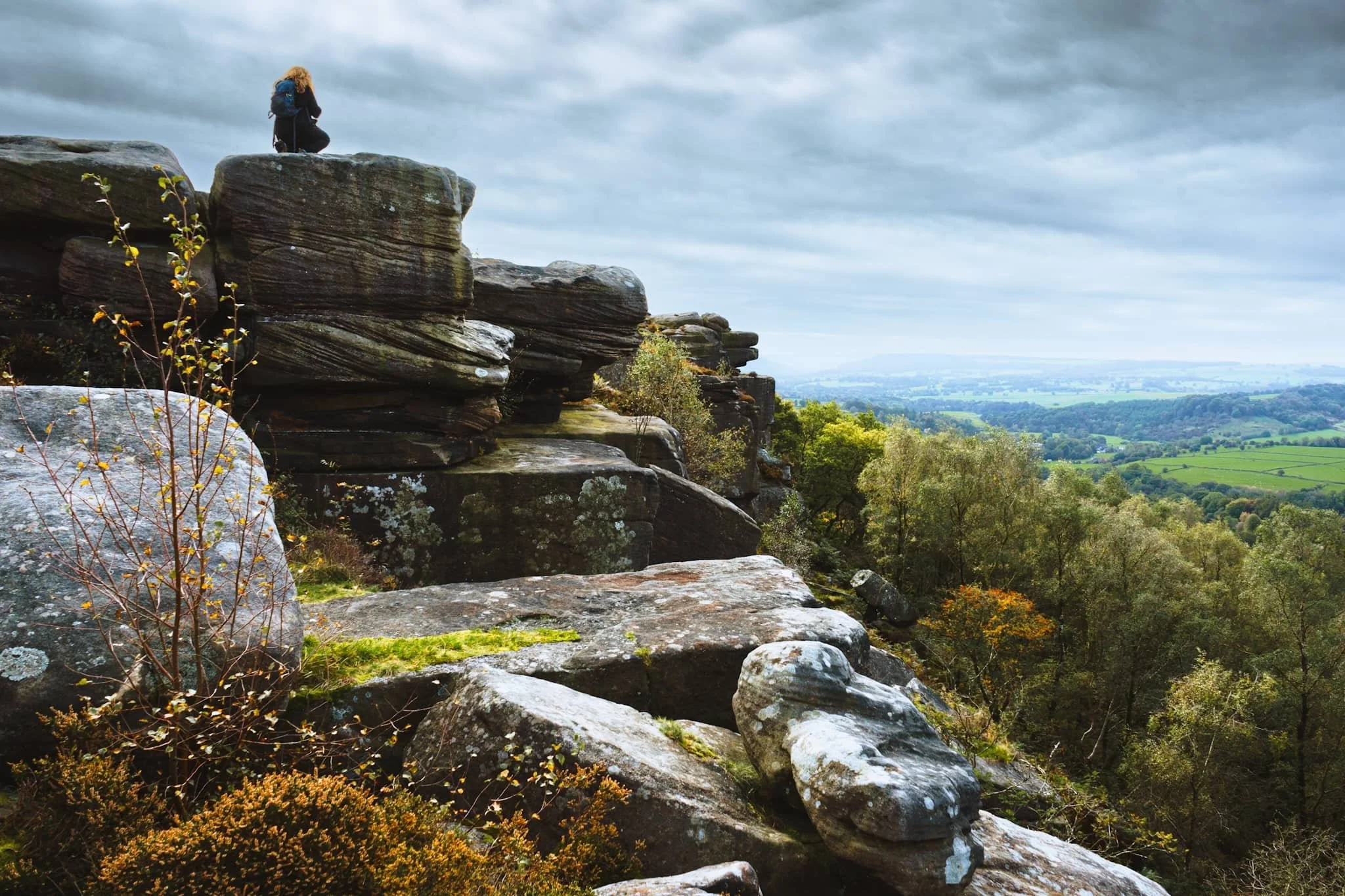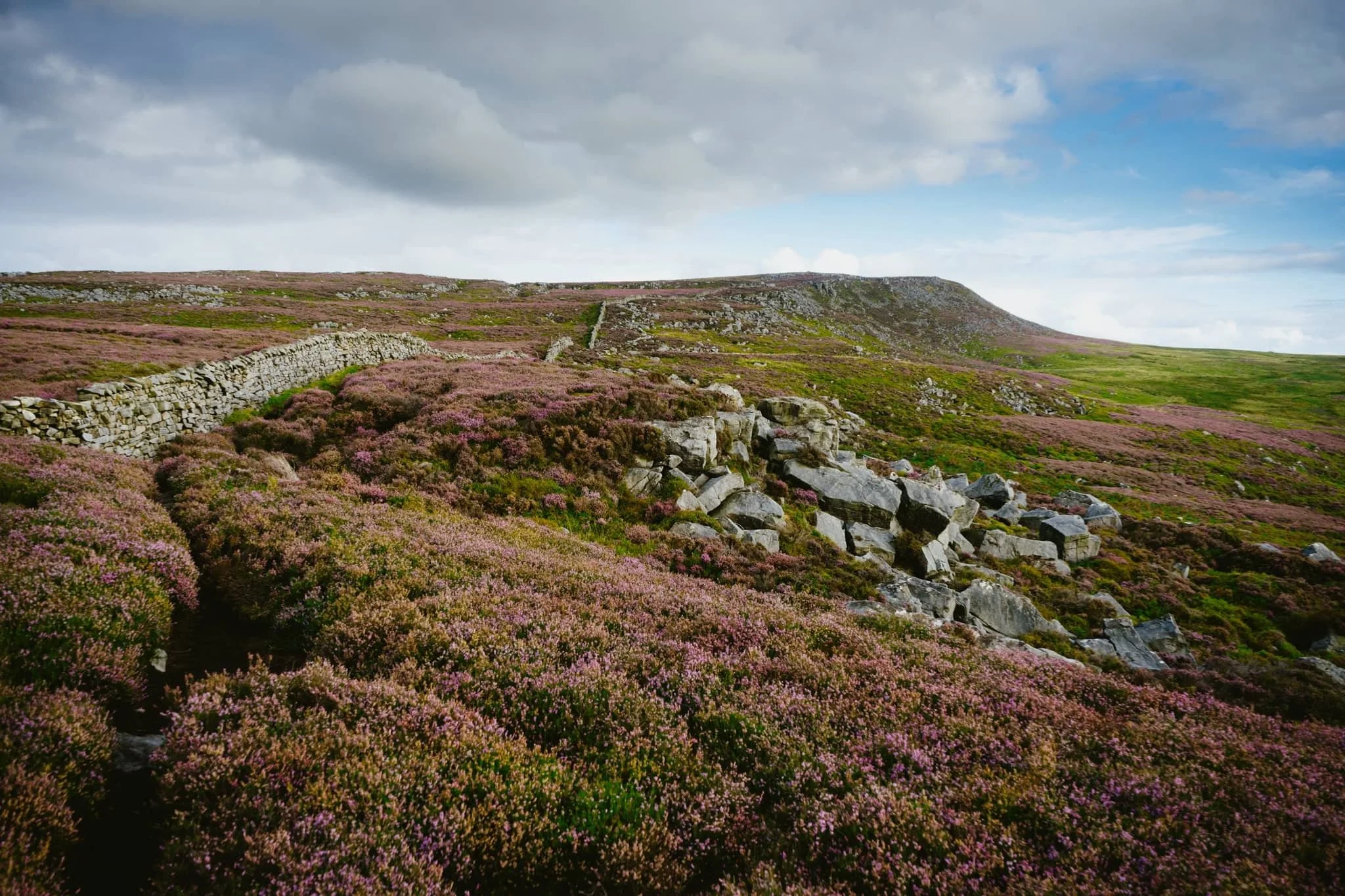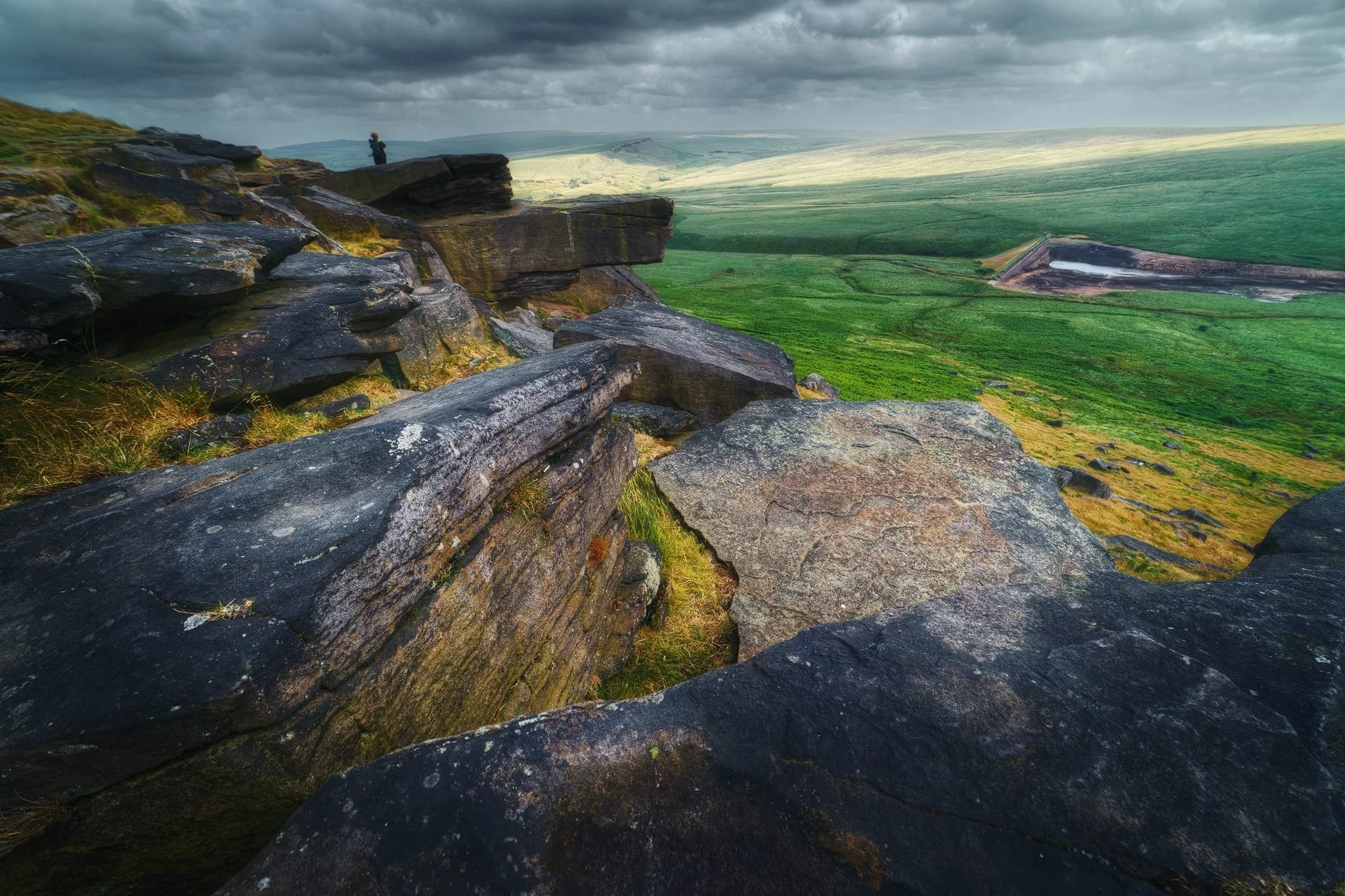Froggatt and Curbar Edges, Peak District, Autumn
If there’s one thing that the Peak District has a lot of, it’s Edges.
If there’s one thing that the Peak District has a lot of, it’s Edges.
The Peak District can roughly be divided into two areas: the White Peak, and the Dark Peak. The naming is based on the underlying geology: the White Park is limestone, and the Dark Peak is gritstone.
You’ll find the Peak District’s edges exclusively in the Dark Peak, particularly the eastern part of the National Park. From below, they appear has formidable walls and cliffs with fantastical rock formations and crags. Beyond those crags usually lies acres of boggy moorland.
On this particular occasion, we decided to explore every nook and cranny of two of the more famous edges: Froggatt Edge and Curbar Edge. They form a near-continuous route, north to south.
The day was bright, much cooler, and clear, save for the creeping clouds that gradually covered the sun as the day went on. Nevertheless, the scenes were absolutely sublime.
All photos taken on my Sony a7ii using my Sony FE 28–70mm f3.5–5.6 OSS and Vivitar “Series 1” 70–210mm f2.8–4.0 zoom lenses. RAWs developed and edited in Lightroom for iPad, finalised in Darkroom for iPad.
Froggatt & Curbar Edges, Peak District, Autumn by Ian Cylkowski is licensed under CC BY-NC-SA 4.0
Starting from the north, the first part of the walk involves a beautiful woodland, Froggatt Woods, full of silver birch and autumnal ferns.
Emerging out of the woods, the views quickly open up and we find our first clump of gritstone boulders to climb around. Lisabet immediately hopped on one for a better view.
Already my excitement levels build as a veritable playground of compositions and rock formations present themselves to me.
A smooth nook in this boulder provided a nice foreground composition, with other crags forming a lead line towards the distant Upper Derwent Valley.
Lisabet’s woodland elf-like abilities means she easily clambers up to the highest boulder to nab those special photos. For me, her slight frame provides wonderful context for the scene.
An isolated pillar of a crag, whipped into otherworldly shapes by millennia or wind and rain, provides a lovely subject for this composition of heather, tors, and across the valley.
Navigating through the various crags and boulders, a little gap catches my eye. As peep through it, a sheer cliff wall down to the valley floor makes my stomach grip. And of course, I snap a photo to convey this sudden drop.
There’s not much separation between Froggatt and Curbar Edge. However, the drop from Curbar Edge is even more severe. This gap between two walls of gritstone provides a lovely leading line towards Baslow Edge in the distance.
Clambering on top of the some of the crags, these beautifully smoothed boulders with deep fissures provide a paradise of compositions, which I line up with Baslow Edge far away.
The staggeringly sheer drop down from the top of Curbar Edge is a sensation I’ll never forget.
This was about as close as I dared to the edge of the precipitous fall to the valley bottom from Curbar Edge.
A stronger burst of sun pulls out all the detail and texture in these windshaped crags.
The amount of heather up on Curbar and Froggatt Edge makes me realise that I need to come back here in late summer, when the heather’s vibrant magenta flowers will carpet the landscape.
Two neighbouring boulders, blasted by wind and rain for millennia, give another gorgeous composition to shoot as stronger sunlight emerges.
Quarrying has occurred on the Peak District’s various edges for centuries. The hard-wearing gritstone made for great millstones, used to grind grain like oats, barley and rye or other feedstuffs.
A lady rests in a nook on Curbar Edge, taking in the panoramic views whilst talking on her phone. She gave the scene a wonderful sense of context and scale that I couldn’t ignore.
Another isolated pinnacle of gritstone catches my eye. As the sun emerges again from the clouds, I line up this composition, using the various boulders to point a zigzagging route to the pinnacle.
Great slabs of gritstone with fissures and covered in lichen allow me to draw another composition looking north as the sun bathes the scene.
After we stopped from lunch using a boulder as shelter, we head back north along the trail. I equip my longer 70–210 mm lens to try and nail some zoomed in, tighter compositions. Here, from the edge, I zoom in on Stony Middleton nestled in its deep limestone gorge.
I enjoyed zooming in on the fell side as it caught the light; the land neatly divided by drystone walls, as a contrast to the pillars of rough gritstone.
Did you enjoy these photos?
Clougha Pike, Forest of Bowland, Lancashire, Summer
The last few weeks have been… tough.
The last few weeks have been… tough.
Not long after our hike to and around Stockghyll Force, I managed to acquire some form of vertigo for a few days, which was decidedly unpleasant. The following week, my lovely Lisabet came down with a rather nasty summer cold, and I managed to fall down the stairs, spraining my wrist and severely bruising my butt. Then the week after, I caught Lisabet’s cold.
Yeesh.
Finally though, we were both fit and healthy, ready to get back out in nature. Following wise counsel from our nature expert friend, Andrew, we embarked on a completely new hike for us: the Clougha Pike circular.
Clougha Pike is the westernmost summit in the Forest of Bowland Area of Outstanding Natural Beauty. Many peaks in the Forest of Bowland are gristone fells surrounded by heather-covered peat moorland, blanket bog, and deep wooded valleys. Clougha Pike is no different, though its southern face drops away dramatically to the valley floor, and is clearly visible from most areas around Lancaster.
I ended up being in rather a lot of pain for this 10km hike. For reasons unknown to me, I slowly developed a blistering headache as the hike went on. This was paired with a sore neck (from having to look down at my footing a lot), sore knees (an every day occurrence), and painful feet (soles in my boots are now too thin).
Oh also, around the lower areas of the walk, having to deal with all the sheep flies and deer flies.
Despite all of this, the hike was gorgeous. The heather was in full bloom, covering the land and fells in carpets of mauve flowers. We were also experiencing the tail end of Storm Betty, so the higher we ascended the more the 50 mph winds punched our bodies.
All in all, it made for an epic day, and crackin’ photos.
Photos taken on my Sony α7ii using my Sony FE 28–70mm f3.5–5.6 OSS zoom lens. RAWS developed in Lightroom for iPad using RNI Films’ Fortia SP film emulation, then finalised in Affinity Photo 2 for iPad.
Clougha Pike, Forest of Bowland, Lancashire, Summer by Ian Cylkowski is licensed under CC BY-NC-SA 4.0
Just a few yards from the car park and already we could see the extent of all the pinky purple heather blooming in the area.
This trail is the more direct route up to Clougha Pike. But for our hike, we chose a more circular clockwise route, skirting around the old quarries and heading towards Littledale.
The colour contrast between the heather and the grasses was proving too hard to resist.
A small scene of a gristone boulder being enveloped by all the heather, fern, and other moorland vegetation.
Increasingly I delight in finding, composing, and shooting these more intimate scenes in nature.
Miles upon miles of heather moorland give way to the lower folding valleys near Quernmore.
This point marked the beginning of our ascent of the fellside above Littledale, the site of a former quarry.
After crossing the infant River Conder via a concealed viaduct now known as Ottergear Bridge, we continued ascending the fellside above Cragg Wood. In the distance, Caton Moor’s windfarm catches the emerging light.
The trail gently lowered back down the fellside, but not before I captured this delightfully bucolic English view.
Another ascent ahead of us, the time the proper one that takes us all the way up to the Clougha Fell moorland plateau. The cascades of Sweet Beck presented a lovely little composition.
A swaledale yew enjoys the view from the fellside above Sweet Beck, with Caton Moor still drenched in light.
As we start ascending the back of Clougha Fell, the greens of the grass is gradually replaced the pinks of heather and the dark tones of peat, punctuated with boulders of gritstone.
The Caton Moor windfarm still getting soaked in afternoon light. In the distance, the dark clouds press down on the southwestern fells of the Yorkshire Dales.
After tacking the tricky and occasionally boggy trail up the back of Clougha, we finally joined the gravel shooter’s track and the moorland plateau. Rather then heading straight for the summit, we looped around to check this Andy Goldsworthy sculpture.
Of course, we had to take turns clambering into the “chambers” for some photos. The nice thing is, in the 50+ mph winds, these chambers were a nice respite from being constantly wrestled by the wind.
Making our way onto Clougha Fell, I had lots of fun making compositions from all the gritstone formations dotted about everywhere, such as with these boulders and the Yorkshire Dales Three Peaks in the distance.
A gritstone platform with solitary boulders, wrapped in heather, provided a nice scene towards Caton Moor and the dark fells in the distance.
It’s not quite Joe Cornish levels of composition skill, but I’ll get there one day.
A solitary gritstone boulder perched on the moorland plateau serves as a nice subject as it catches the light beneath the stormy skies.
From the summit of Clougha Pike, a mere 413 m/1,355 ft above sea level. Nevertheless, the views are gorgeous. From the summit we can see all the way across the Lune valley, towards Morecambe Bay.
From the summit, our way back down was immediately apparent. It was going to be rocky and steep.
100 m or so below the summit of Clougha Pike, a patch of smoothed gritstone boulders interspersed with heather provide me with another tasty composition.
From below Clougha Pike’s southern face, it’s easy to see how this is such a distinct and recognisable hill from many miles away.
A blast of light from the racing stormy clouds pulls all the gorgeous textures and colours from this scene.
One last look back at Clougha Pike, with heather everywhere, but we continued the descent down into the woodland toward the car park, fighting flies all the way.
Did you enjoy these photos?
Marsden, West Yorkshire, Summer
Time for somewhere a little different.
Time for somewhere a little different.
We’re as guilty as anyone of succumbing to the familiar. Conscious of this, Lisabet and I booked a long weekend somewhere we’d never explored before: the moors of West Yorkshire.
Our “base” for the weekend was the bonny village of Marsden. Much like the rest of West Yorkshire, Marsden was an important mill town known for the production of woollen cloth. The days of hard labour in mills, warehouses, and factories are over, but those grand old buildings remain. These days, Marsden is a vibrant and forward-looking place that enjoys a great food and drink scene, easy travel to Manchester or Leeds, and quick access to the beautiful moorland hills that surround it.
The weather wasn’t as kind to us on this particular break, with persistent and at times heavy rain following us for most of the weekend. We attempted a hike up a well-known local hill, Pule Hill, but quickly turned back as it became clear that the various trails up the hill would be too boggy for us.
Instead, we explored the gorgeous scenery around the Huddersfield Narrow Canal, and possibly the windiest shoot I’ve ever done at Buckstones Edge.
All photos taken on my Sony α7ii using my Sony FE 28–70mm f3.5–5.6 OSS zoom, Vivitar “Series 1” 70–210mm f2.8–4.0 zoom, and Rokinon 14mm f2.8 ED AS IF UMC prime lenses. RAWs converted in Lightroom, developed in Photomatix, and edited and finalised in Photoshop.
Marsden, West Yorkshire, Summer by Ian Cylkowski is licensed under CC BY-NC-SA 4.0
On a small clearing above the canal, we captured an inkling of a view of Marsden and its old buildings and mills.
The Huddersfield Narrow Canal between Marsden and Slaithwaite features plenty of picturesque locks in lovely scenery. The canal itself, though only 20 miles long, has 74 locks.
The canal truly is narrow in name and nature. Near Standedge Tunnel, a splash of colour amongst the brickwork catches my eye.
Many sections of Huddersfield Narrow Canal are beautifully lush and verdant.
This is where Huddersfield Narrow Canal enters Standedge Tunnel, carrying watercraft through and underneath the Pennines. At 5.2 km long, 194 m underground, and 196 m above sea level, Standedge Canal Tunnel is Britain’s longest, deepest, and highest canal tunnel.
Our ultimate destination was Pule Hill above the tunnel, at 434 m/1,434 ft above sea level. Though ultimately we retreated from climbing the summit, we nevertheless got fantastic views of Marsden and the valley it sits in.
An old farm cottage that’s seen better days, but nevertheless enjoys fantastic views.
After clambering and squelching back down the valley into Marsden—and refuelling our bellies—we head up to Buckstone Edge. This rim of the valley above March Haigh Reservoir is lined with Millstone Grit crags and boulders that offer a photographer’s paradise of compositions.
At 1,400 ft above sea level, the wind was blowing a raging storm. Probably one of the windiest shoots I’ve ever done. I wanted to capture that sense of rushing and movement everywhere, contrasted against the still and stubborn boulders and crags.
As a result of the high winds, the clouds above us were rushing across the sky. This allowed for the sun to intermittently paint golden streaks of light across the land. All I had to do was watch, wait, and shoot.
I gingerly clambered down the steep valley side, seeking compositions of the Buckstones pointing towards Pule Hill in the distance.
Some of these Millstone Grit boulders were as big as a car, stubbornly resisting the sheer force of the day’s wind.
After satiating my need for ultra-wide compositions, I equipped my 70–210mm lens for some tighter images. Trying to get a steady shot at 210mm with the wind wrestling my camera was definitely a challenge. Some how, I managed a few sharp images!
Pule Hill, which defeated us earlier in the day. Here, at 210mm, it caught the sun’s fleeting paintbrush as I pressed the shutter.
Beyond the village, I spy the distant hills of Marsden Moor receiving their share of the sun’s brief artistic spurt, and set up a composition at 210mm with the Buckstones.






